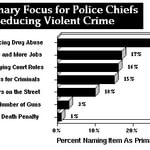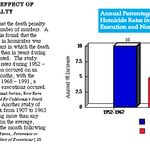Law Enforcement
Deterrence & Murder of Police Officers - According to statistics from the latest FBI Uniform Crime Report, regions of the country that use the death penalty the least are the safest for police officers. Police are most in danger in the south, which accounts for 80% of all executions (90% in 2000). From 1989 – 1998, 292 law enforcement officers were feloniously killed in the south, 125 in the west, 121 in the midwest, and 80 in the northeast, the region with the fewest execution — less than 1%. The three leading states where law enforcement officers were feloniously killed in 1998 were California, the state with the highest death row population (7); Texas, the state with the most executions since 1976 (5); and Florida, the state that is third highest in executions and in death row population (5). (FBI, Uniform Crime Reports, Law Enforcement Officers Killed and Assaulted, 1998)
A 1994 study of the deterrence value of the death penalty focused on whether the death penalty deterred the murder of police officers. The researchers surveyed a thirteen year period of police homicides. The study concluded ” we find no consistent evidence that capital punishment influenced police killings during the 1976 – 1989 period.… [P]olice do not appear to have been afforded an added measure of protection against homicide by capital punishment.” (W. Bailey and R. Peterson, Murder, Capital Punishment, and Deterrence: A Review of the Evidence and an Examination of Police Killings, 50 Journal of Social Issues 53, 71 1994)
Law Enforcement Officers Feloniously Killed 1989 – 1998
| Total | 1998 | 1997 | 1996 | 1995 | 1994 | 1993 | 1992 | 1991 | 1990 | 1989 | |
| South | 292 | 29 | 32 | 24 | 32 | 24 | 31 | 28 | 29 | 31 | 32 |
| West | 125 | 14 | 15 | 6 | 23 | 18 | 11 | 13 | 7 | 9 | 9 |
| Midwest | 121 | 10 | 11 | 15 | 8 | 16 | 11 | 8 | 20 | 14 | 8 |
| Northeast | 80 | 3 | 7 | 10 | 8 | 12 | 9 | 8 | 7 | 7 | 9 |
On the Front Line: Law Enforcement Views on the Death Penalty A 1995 national survey of police chiefs from around the country discredits the repeated assertion that the death penalty is an important law enforcement tool.

Criminologists’ Views
A survey of experts from the American Society of Criminology, the Academy of Criminal Justice Sciences, and the Law
and Society Association showed that the overwhelming majority did not believe that the death penalty is a proven deterrent to homicide. Over 80% believe the existing research fails to support a deterrence justification for the death penalty. Similarly, over 75% of those polled do not believe that increasing the number of executions, or decreasing the time spent on death row before execution, would produce a general deterrent effect. (M. Radelet and R. Akers, Deterrence and the Death
Penalty: The Views of the Experts, 1995)
Brutalization

Research reported in Homicide Studies, Vol. 1, No.2, May 1997, indicates that executions may actually increase the number of murders, rather than deter murders. Prof. Ernie Thomson at Arizona State University reported a brutalizing effect from an execution in Arizona, consistent with the results of a similar study in Oklahoma.
Deaths of Children in the US: New Report — Apparently, the US’s use of the death penalty is not improving its standing in the world community when it comes to the deaths of children. In a February 7, 1997 Report from the Centers for Disease Control and Prevention (CDC) (part of U.S Dept. of Health and Human Services), from 1950 – 1993 child homicide rates in the U. S. tripled. CDC compared the U.S. with 25 other industrialized countries and found that “the United States has the highest rates of childhood homicide, suicide, and firearm-related death among industrialized countries.” Almost all of these other industrialized countries have stopped using the death penalty The report found that:
- The overall firearm-related death rate among U.S. children less than 15 years of age was 12 times higher than among children in the other 25 countries combined.
- The firearm-related homicide rate in the U.S. was nearly 16 times higher than in all of the other countries combined.
- The firearm-related suicide rate was nearly 11 times higher.
The report noted that previous studies have shown an association between rates of violent childhood death and low funding for social programs, economic stress related to participation of women in the labor force, divorce, ethnic-linguistic heterogeneity, and social acceptability of violence. (Rates of Homicide, Suicide, and Firearm-Related Death Among Children — 26 Industrialized Countries, 46 Morbidity and Mortality Weekly Report 101 (Feb 7, 1997))
In comparing the rate of death by handguns in eight industrialized countries, the United States stands out with a rate of death by handguns that is much higher than the rate of other countries. The United States is also the only country of the eight to retain use of the death penalty. In most foreign countries, gun control laws are more restrictive and gun owners are assigned more responsibility. (Washington Post, 4/4/98)



